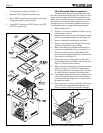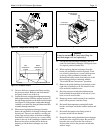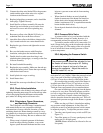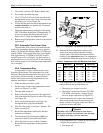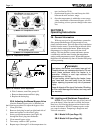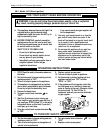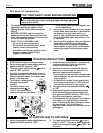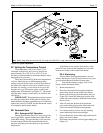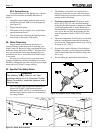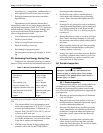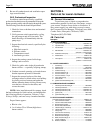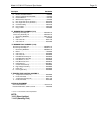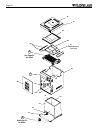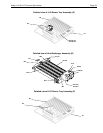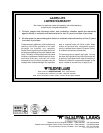
Model LLG & LLD Pool and Spa Heater
Page 19
discourage further adjustments.
4. Set the filter time clock to start the pump no
earlier than 6:00 AM during the pool heating
season. This is the time when nightly heat loss
balances.
5. If the pool is only going to be used on weekends,
reduce the heater temperature control setting by 8
or 10 degrees during the week. Reset it to the
78°F (25°C) level a day or so before you plan to
use the pool.
6. During the winter or when on vacation for longer
than a week, shut down the heater by following
the shut-down instructions found on the inside of
the heater.
7. Where possible, shelter the pool from prevailing
winds with well-trimmed hedges or other land-
scaping, cabanas, or fencing.
8. Always use a pool cover when practical. Besides
providing a valuable safety feature, a pool cover
will reduce heat loss, conserve chemicals, and
reduce the load on filter systems.
3H. Periodic Inspection
WARNING
Improper installation or maintenance can
cause nausea or asphyxiation from carbon
monoxide in flue gases which could result in
severe injury, or death.
3H-1. Owner Inspection
Teledyne Laars designs and constructs the Laars
Lite heater to provide long performance life when
installed and operated properly under normal condi-
tions. The following basic guidelines are suggested for
your inspection:
1. Keep the top and surrounding area of the heater
clear of all debris.
2. Keep the heater area clean and free of all com-
bustible materials, flammable liquids and vapors,
as well as sanitization chemicals.
3. Do not use the heater if any part has been under
water. Immediately call a qualified professional
technician to inspect the heater and replace any
part of the control system which has been sub-
merged.
4. If the heater is equipped with a pressure relief
valve, check for corrosion and make sure that
water runs freely through it. If corrosion is found,
replace the pressure relief valve.
drowsiness (e.g., tranquilizers, antihistamines, or
anticoagulants) should not use spas or hot tubs.
7. Prolonged immersion in hot water can induce
hyperthermia.
Hyperthermia occurs when the internal body
temperature reaches a level several degrees above the
normal body temperature of 98.6°F (37°C). Symptoms
include dizziness, fainting, drowsiness, lethargy, and
an increase in the internal body temperature. The
effects of hyperthermia include:
• Lack of awareness of impending hazard
• Failure to perceive heat
• Failure to recognize need to leave spa
• Physical inability to leave spa
• Fetal damage in pregnant women
• Unconsciousness resulting in a danger of drown-
ing
3G. Swimming Pool Energy Saving Tips
Teledyne Laars offers the following recommen-
dations to help conserve fuel and minimize the cost of
Table 7. Mineral Concentration Levels
Test Recommended Level
Free chlorine 1.0 to 3.0 ppm
Bromine 3.0 to 5.0 ppm
pH 7.2 to 7.8
Total alkalinity (TA) 80 to 120 ppm
Calcium hardness (CH) 200 to 400 ppm
Langelier saturation index (LSI) -0.5 to +0.5
Total dissolved solids (TDS) Less than 2000 ppm
Cyanuric acid 30 to 150 ppm
Copper 0 ppm
operating your pool heater without sacrificing com-
fort.
1. The American Red Cross recommends a maxi-
mum water temperature of 78°F (25°C). Use an
accurate pool thermometer. A difference of 4
degrees, from 78 to 82°F (25 to 28°C), will use
as much as 40% more gas.
2. Carefully monitor the water temperature of your
pool in the summertime. You can reduce heater
usage due to warmer air temperatures.
3. Find the proper setting on the pool heater tem-
perature control and use the TEMP-LOK to



